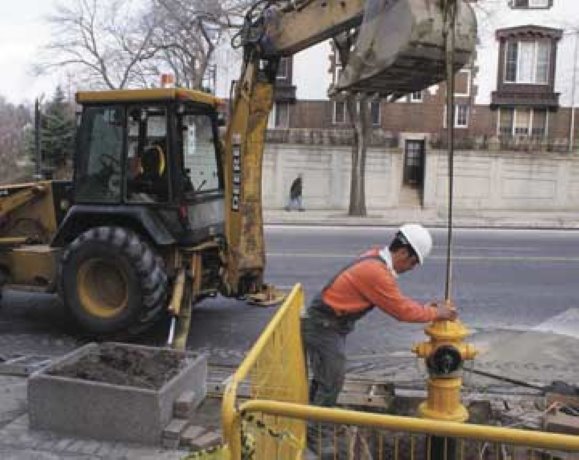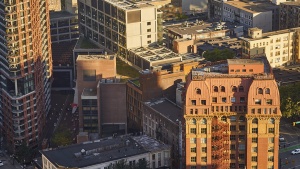Toronto’s Yonge Street corridor, which runs north from Eglinton Avenue to Lawrence Avenue, experiences a high volume of both vehicle and pedestrian traffic during most of the year.
The Yonge Street corridor running north from Eglinton Avenue to Lawrence Avenue experiences a high volume of both vehicle and pedestrian traffic during most of the year. In a watermain replacement program concluding in May, the City of Toronto replaced not one, but two water mains running on either side of the street, and because the street is loaded with existing infrastructure, much of that work occurred in the middle of the sidewalk.
Luis De Jesus, Senior Engineer, Technical Services with the City of Toronto oversaw the project, undertaken by contractor CO-X-CO Construction Ltd. of Toronto.
“Based on the recurrence of watermain breaks on that section, we decided it would be more cost-beneficial to replace the mains,” says De Jesus. “We’re replacing two old cast-iron watermains starting right at the Eglinton intersection and we’re working our way to just south of Lawrence Avenue.
“There were cast-iron mains on both sides of Yonge, but there’s so much infrastructure buried in the street that it made more sense for us to put in two new PVC lines, rather than try to run one new main and cross the street with new hook-ups. We wanted to avoid the TTC subway infrastructure, which runs right down the middle of the street, and to be honest, there’s still old TTC streetcar tracks dating back to the 1950s underneath the asphalt. The whole project was a challenge because it involved very tight construction with the sheer density of all the utilities.”
Natural gas lines had been upgraded by Enbridge in 2007, and the lines were well marked.
Underneath the roadway, the contractor worked around a maze of utilities and infrastructure, including, television cable, telephone lines, fibre optic cable, sewer lines, conduits encased in concrete and the existing watermains, which had to be kept functioning while the new installation took place.
Other infrastructure included large hydro lines related to the Glengrove electrical substation on the east side of the street, and abandoned sewer lines filled with concrete to maintain road support.
Some of the abandoned infrastructure was removed, depending on the degree of difficulty involved. “We always look at it from a cost-benefit analysis,” says De Jesus. “There has to be a benefit in removing it.”
The new mains were installed at curbside whenever possible to avoid disrupting pedestrian traffic.
“On the west side of the street, it often made more sense to cut straight through the sidewalk,” says De Jesus. “On the east side we were able, for the most part, to stick to the curb lane.”
Police officers directed heavy traffic along Yonge, with only a brief scheduled respite to allow Christmas shoppers access to storefronts. “We have a very good contractor in CO-X-CO,” says De Jesus. “I have to give them credit for following all of the safety requirements and creating the proper delineations for traffic.”
Inclement weather held up work the following month. “In January, half the days were extremely cold, with wind chills below -30C,” says de Jesus. “On some days snowfalls were so heavy it wasn’t safe to be in the roadway, so work was stopped. But this winter, February was nice to us and pretty mild for the most part.”
Some customers on the west side are already hooked up to the new service, and the main on the east side is being flushed and pressure-tested tested prior to hookup. Testing is often a lengthy procedure because city standards are more stringent than those set by the province.
“It’s been a long nine months,” says De Jesus. “Now that this project is coming to an end, we’re ready to advertise a public tender to resurface the road and repair the sidewalks.”











Recent Comments
comments for this post are closed